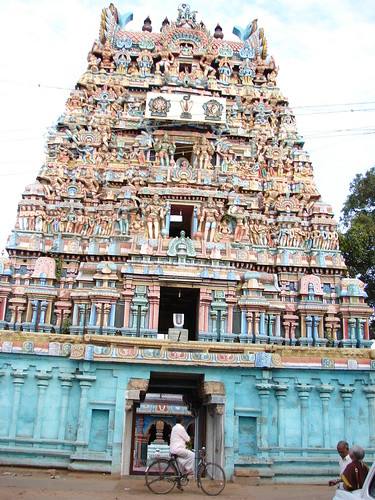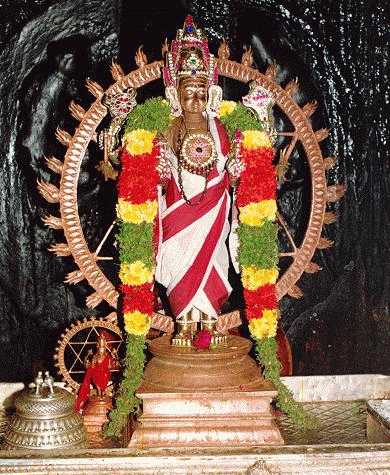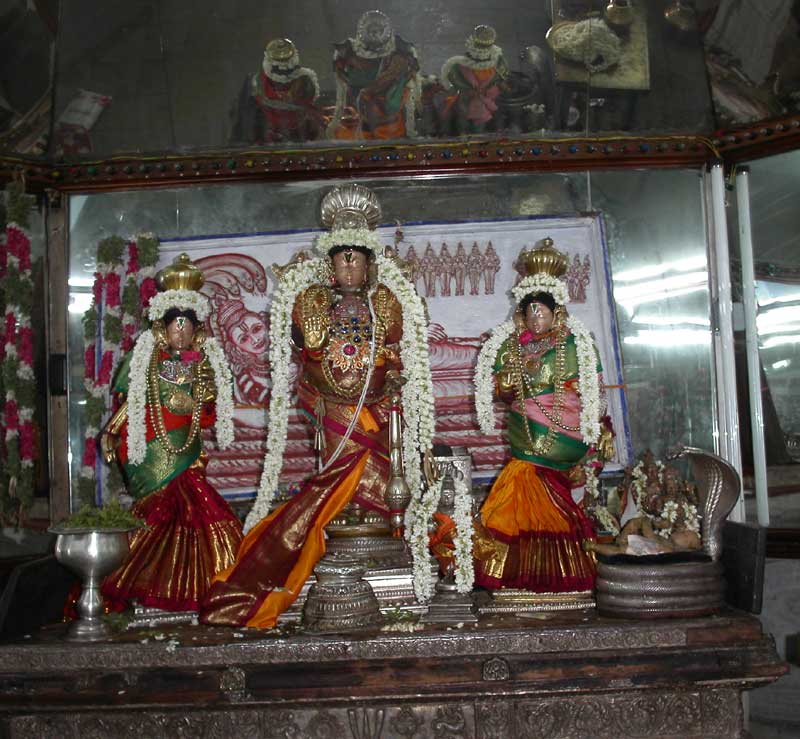Upanishadam udaran ugdamanye pandavartham saranamupayadan na: prayate sarngadhanva
God protects us. For the sake of Pandavas, who surrendered unto Him, He gave the essence of Upanishad, as Bhagavat Gita. While naming the Lord, Swami Desika has not used the names such as Sri Krishna or Sri Gitacharya, but Sri Sarngadhanva. So on any aspect, be it the Chariot or Sri Aravamudha or Swami Desika's identifying the preacher as Sri Sarngapani. we can see the strong relationship between Gita and this Kshetram. In the corridor we can see Pathala Srinivasa sannidhi, situated below ground. Sri Srinivasa is gracing here. We saw that the Lord left Vaikuntam and came to Thirumala to marry Sri Padmavati Thayar. Narada who always indulges in actions which will finally yield good results at the end, told where the Lord was to Sri MahaLakshmi at Kolapuri and similarly mentioned to the Lord the whereabouts of Sri Thayar. Both, therefore arrived at this Kshetram. In a game, the Lord hid Himself in the ground before marrying the Sri Thayar as Sri Komalavalli; and that is how this Pathala Srinivasa sannidhi came into existence. We are now seeing the Vaideeka vimanam on the garbhagruha. It is same as the Pranavakara vimanam in Srirangam. It may be remembered that Pranavakara vimanam was gifted by Brahma to Ikshvaku Kings and after the Pattabhishekam of Sri Rama, it was gifted to Vibheeshana, who seeing the beauty of Srirangam, established the vimanam in Srirangam. Pranavam is the seed of the spread out Vedas and so Vaideeka vimanam is the shoot of the Pranavakara vimanam. The Lord desired to rest here, just as in Srirangam. While Srirangam is between Kaveri and Kollidam, Kumbakonam is between Kaveri and Arasalaru. A part of Pranavakara vimanam was planted here as Vaideeka vimanam. The Lord [Moolavar] also is in a reclining pose. What is told in the next sloka of Gita - sloka 24 of Chapter 8 - depicts the present sannidhi. Entrance to this sannidhi is from two gates - Utharayana gate and Dakshinayana gate. The Lord is reclining with the feet stretched to North. The gate near His feet is called Utharayana gate and near this we can see the images of His and Her feet. From Thai to Aani [mid January to mid July] this gate only is opened for entry by devotees. From Aadi to Margazhi, the other gate on the South side -Dakshinayana gate- is opened and Uthrayana gate will remain closed. So by coming via the Uthrayana gate we reach His feet. Utharam means greatness and so now in sloka 24, the Lord is going to tell the greatness of the Uthrayana route [marga]:
agnir jyotir ahah suklah
san-masa uttarayanam
tatra prayata gacchanti
brahma brahma-vido janah
"Those who know the Supreme Brahman attain that Supreme by passing away from the world , crossing the places of light, place of the gods for daytime, waxing phase of moon, utharyanam."
Sri Krishna tells of Archiradhi marg or the no-return [to samsaram] route. This sloka mentions some places. These are the places to be noted in the Archiradhi route. Atman has to depart from this world to Moksham, for which all preparations have all been made. After dying, jeevatman chooses the Sushumna nadi, one of the 101 nerves emanating from the heart and reaching the apex point on the person's head [brahmaranthram] and exits. This is explained in Chandogya Upanishad and in other Upanishads also. Swami Nadathur Ammal, in his Tatva saram, explains very clearly. Atman might have countless births; but once reaches Moksham via this route never is reborn. We all should long to travel in this route on one day. Archit means light and so archiradhi marg means firstly light filled route. That is why Sri Krishna tells jyoti = light. Aha = the place of residence of the god for day time. Sukla = place of the god for shukla paksha or the growing phase of the Moon. Utharayanam = the place of the god for Utharayanam. Thus four places, viz. of light, of Daytime, of Shukla paksh and of Utharayanam are mentioned. In Upanishads in addition the place of Samvatsaram [ god for year], Vayu [air] lok, Surya lok, Chandra lok, Vidyut [lightning] lok, Varuna [rain god] lok, Indra lok and Satya lok [of Brahma] are mentioned. Thus there are 12 places [ Four mentioned in the Gita sloka and eight more mentioned in Upanishads] the atman crosses. Atman travels a very great distance to cross the moola prakruti. Then atman comes across Viraja river. Getting into this river and after a bath atman would reach Vaikuntam and then there is no return for him. Atman lives for ever in the service of the Lord. Tatra prayata = those travelling in this route, brahma vido = desirous of reaching Brahmam, brahma gacchanti = they reach the place of Brahmam, that is Vaikuntam. Now we can realize the connection between this sannidhi and this sloka. In the next sloka Sri Krishna is going to tell about the result of going by Dakshinayana route. Atman travelling by that route goes to other places and returns to Universe. Here in this sannidhi while doing archana to the Lord one Divine name is mentioned. ' Ayana dvisaya utrancha prani moksha pradhayaka'. Two ayanams- Utharyanam and Dakshinayanam, utrancha = exiting, prani = living beings, moksha pradhayaka = grants Moksham.






